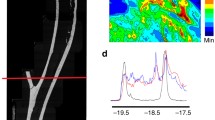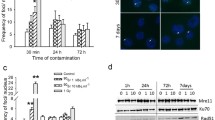Abstract
Depleted uranium (DU) is a dense heavy metal used in military applications. During military conflicts, US military personnel have been wounded by DU shrapnel. The health effects of embedded DU are unknown. Published data from our laboratory demonstrated that DU exposure in vitro can transform immortalized human osteoblast cells (HOS) to the tumorigenic phenotype. Results from our laboratory have also shown that DU is genotoxic and mutagenic in cultured human cells. Internalized DU could be a carcinogenic risk and concurrent alpha particle and heavy metal toxic effects complicate this potential risk. Anecdotal reports have suggested that DU can cause leukemia. To better assess this risk, we have developed an in vivo leukemogenesis model. This model involves using murine hematopoietic cells (FDC-P1) that are dependent on stimulation by granulocyte-macrophage colony stimulating factor (GM-CSF) or interleukin 3 (IL-3) and injected into mice to produce myeloid leukemia. Although immortalized, these cells are not tumorigenic on subcutaneous inoculation in mice. Intravenous injection of FDC-P1 cells into DU-implanted DBA/2 mice was followed by the development of leukemias in 76% of all mice implanted with DU pellets. In contrast, only 12% of control mice developed leukemia. Karyotypic analysis confirmed that the leukemias originated from FDC-P1 cells. The growth properties of leukemic cells from bone marrow, spleen, and lymph node were assessed and indicate that the FDC-P1 cells had become transformed in vivo. The kidney, spleen, bone marrow, muscle, and urine showed significant elevations in tissue uranium levels prior to induction of leukemia. These results demonstrated that a DU altered in vivo environment may be involved in the pathogenesis of DU induced leukemia in an animal model.
Similar content being viewed by others
Abbreviations
- DU:
-
depleted uranium
- FDC-P1:
-
factor-dependent cells
- IL-3:
-
interleukin 3
References
Miller AC, Blakely WF, Livengood D, Whittaker T, Xu J, Ejnik JW, Hamilton MM, Parlette E, St. John T, Gerstenberg HM, Hsu H: Transformation of human osteoblast cells to the tumorigenic phenotype by depleted uranium-uranyl chloride. Environ Health Perspect 106: 465–471, 1998
Miller AC, Fuciarelli AF, Jackson WE, Ejnik EJ, Emond C, Strocko S, Hogan J, Page N, Pellmar T: Urinary and serum mutagenicity studies with rats implanted with depleted uranium or tantalum pellets. Mutagenesis 13: 101–106, 1998
Andrew SP, Caligiuri RD, Eiselstein LE: A review of penetration mechanisms and dynamic properties of tungsten and depleted uranium penetrators. In: A. Crowson, E.S. Chen (eds). Tungsten and Tungsten Alloys: Recent Advances, Plenum Press, NY, 1991
Miller AC, Whittaker T, Hogan J, McBride S, Benson K: Oncogenes as biomarkers for low dose radiation-induced health effects. Can Detect Prev 20: 235–236, 1996
Pellmar TC, Fuciarelli AF, Ejnik JW, Hamilton M, Hogan J, Strocko S, Emond C, Mottaz HM, Landauer MR: Distribution of uranium in rats implanted with depleted uranium pellets. Toxicol Sci 49: 29–39, 1999
Pellmar TC, Kaiser DO, Emond C, Hogan JB: Electrophysiological changes in hippocampal slices isolated from rats embedded with depleted uranium fragments. Neurotoxicology 20: 785–792, 1999
Miller AC, Xu J, Mog S, McKinney L, Page N: Neoplastic transformation of human osteoblast cells to the tumorigenic phenotype by heavy metal-tungsten alloy particles: Induction of genotoxic effects. Carcinogenesis 22: 115–125, 2001
Miller AC, Brooks K, Stewart M, Shi L, McClain D, Page N: Genomic instability in human osteoblast cells after exposure to depleted uranium: Delayed lethality and micronucleus formation. J Environ Radioact 64: 247–259, 2003
Miller AC, Xu J, Stewart M, Brooks K, Hodge S, Shi L, Page N, McClain D: Observation of radiation specific damage in human cells exposed to depleted uranium: Dicentric frequency and neoplastic transformation as endpoints. Radiat Protect Dosim 99: 275–278, 2002
Miller AC, Brooks K, Smith J, Page N: Effect of militarily relevant heavy metals, depleted uranium and heavy metal tungsten alloy on gene expression in human liver carcinoma cells [HePG2]. Molec Cell Biochem 255: 247–256, 2004vadjust
Mould RF: Depleted uranium and radiation-induced lung cancer and leukemia. Br Radiol 74: 677–683, 2001
Duhrsen D, Metcalf D: A model system for leukemic transformation of immortalized hemopoietic cells in irradiated recipient mice. Leukemia 2: 329–333, 1988
Duhrsen D, Metcalf D: Factors influencing the time and site of leukemic transformation of factor-dependent cells after injection into irradiated recipient mice. Int J Can 44: 1074–1081, 1989
Duhrsen D, Metcalf D. Effects of irradiation of recipient mice on the behavior and leukemogenic potential of factor-dependent hematopoietic cell lines. Blood 75: 190–197, 1990
Blumenstein M, Hossfield DK, Duhrsen U: Indirect radiation leukemogenesis in DBA/2 mice: Increased expression of B2 repeats in FDC-P1 cells transformed by intracisternal A-particle transposition. Ann Hematol 76: 53–60, 1998
Ejnik JW, Carmichael AJ, Hamilton MM, McDiarmid M, Squibb K, Boyd P, Tardiff W: Determination of the isotopic composition of uranium in urine by inductively coupled plasma mass spectrometry. Health Phys 78: 143–146, 2000
Danesi PR, Bleise A, Burkart W, Cabianca T, Campbell MJ, Makarewicz M, Moreno J, Tuniz C, Hotchkis M: Isotopic composition and origin of uranium and plutonium in selected soil samples collected in Kosovo. J Environ Radioact 64: 121–131, 2003
National Research Council Committee on Biological Effects of Ionizing Radiation: Health Effects of Exposure to Radon – BEIR VI, National Academy Press, Washington, DC, 1999
Ellender M. Harrison JD, Pottinger H, Thomas JM: Induction of osteosarcoma and acute myeloid leukaemia in CBA/H mice by the alpha-emitting nuclides, uranium-233, plutonium-239, and amercium-241. Int J Radiat Biol 77: 41–52, 2001
Harrison JD, Muirhead CR, Harrison: Quantitative comparisons of cancer induction in humans by internally deposited radionuclides and external radiation. Int J Radiat Biol 79: 1–13, 2003
Waalkes MP, Rehm S, Sass B, Ward JM: Induction of tumors of the hematopoietic system by cadmium in rats. IARC Sci Pub 118: 401–404, 1992
Costa M: Molecular mechanisms of nickel carcinogenesis. J Biol Chem 383: 961–967, 2002
Shi X: Molecular mechanisms of Cr[VI]-induced carcinogenesis. Mol Cell Biochem 234: 293–300, 2002
Author information
Authors and Affiliations
Corresponding author
Rights and permissions
About this article
Cite this article
Miller, A.C., Bonait-Pellie, C., Merlot, R.F. et al. Leukemic transformation of hematopoietic cells in mice internally exposed to depleted uranium. Mol Cell Biochem 279, 97–104 (2005). https://doi.org/10.1007/s11010-005-8226-z
Issue Date:
DOI: https://doi.org/10.1007/s11010-005-8226-z




